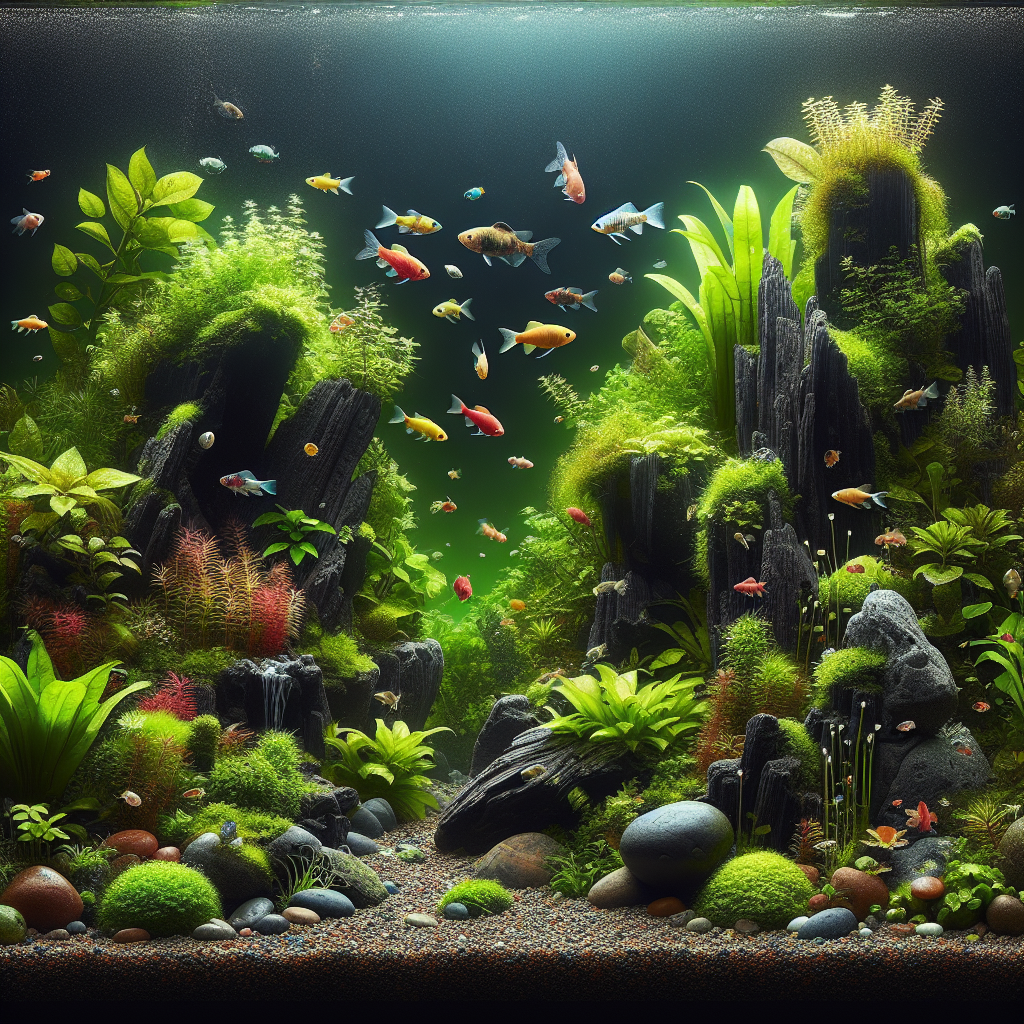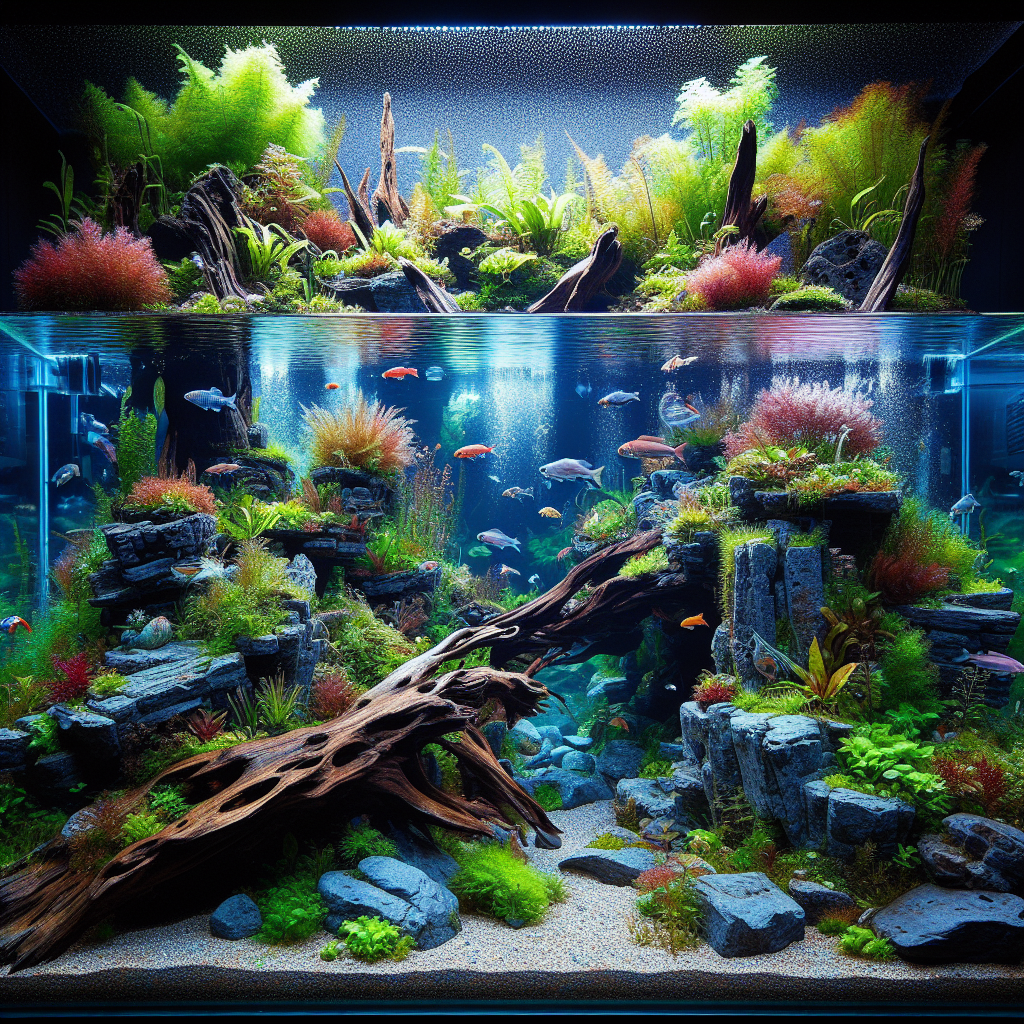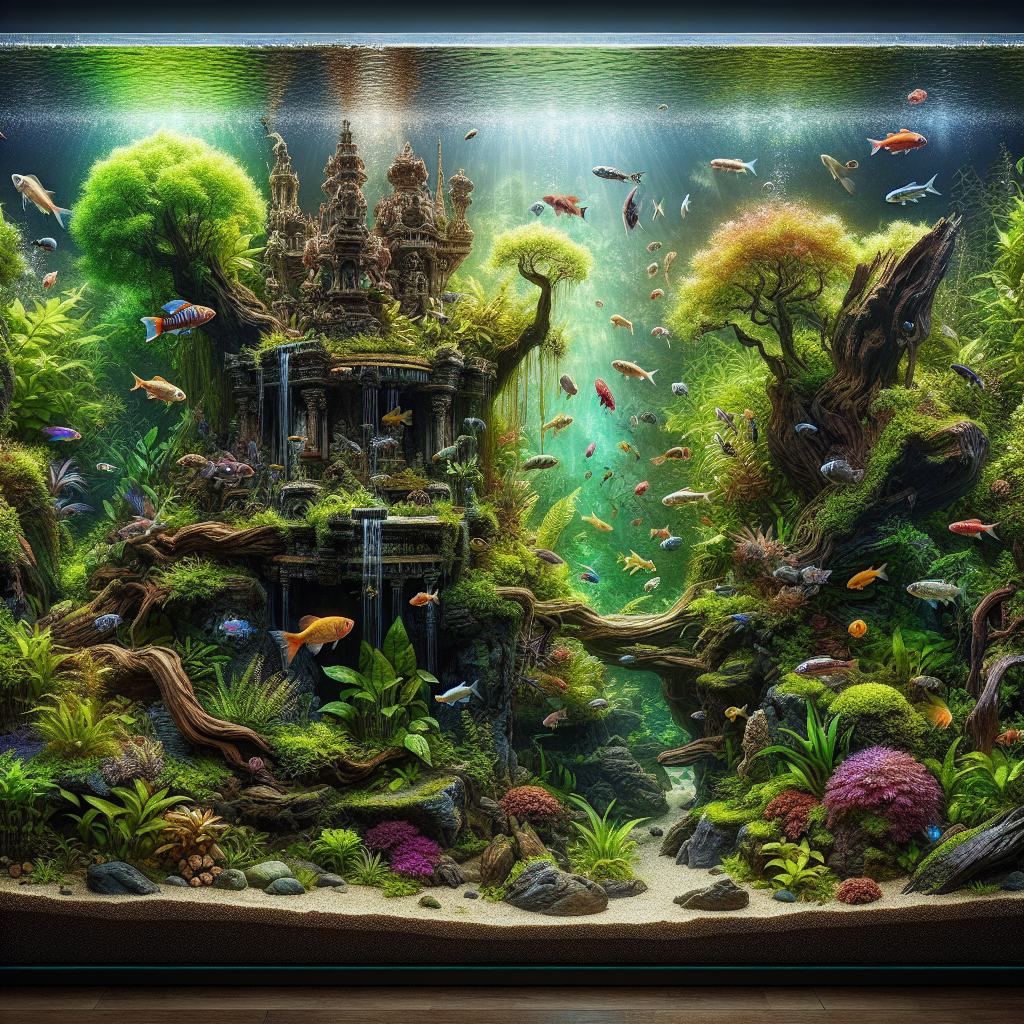Creative Ideas and Techniques for Stunning Aquarium Designs
The enchanting world of aquascaping transforms ordinary aquariums into captivating works of art, where nature’s beauty is meticulously curated within glass confines. As an innovative form of underwater gardening, aquascaping involves the harmonious arrangement of aquatic plants, rocks, stones, and driftwood to create breathtaking landscapes that mimic natural environments. This creative endeavor goes beyond mere decoration, offering a profound connection with nature and a unique artistic outlet.
Central to aquascaping is the delicate balance between aesthetics and biology. By understanding the intricacies of plant growth, light conditions, and water chemistry, hobbyists can design aquascapes that are not only visually stunning but also sustainable ecosystems. With endless possibilities, enthusiasts can draw inspiration from diverse aquatic habitats, from lush riverbanks to serene forest pools, to craft their personalized aquatic masterpieces.
As the popularity of aquascaping continues to grow, so does the breadth of creative ideas and techniques available to enthusiasts. Whether you’re a beginner eager to embark on your first aquascape or a seasoned expert seeking fresh inspiration, exploring the art of aquascaping promises a journey of discovery and creativity. Dive into this vibrant world, where imagination meets nature, and unlock the secrets to creating stunning aquarium designs that captivate and inspire.
Understanding What is Aquascaping: The Basics and Fundamentals

Exploring the basics of aquascaping is akin to embarking on an underwater journey where creativity and nature intertwine. But what exactly is aquascaping, and how did it evolve into the captivating art form we see today? Let’s dive deeper into its history and the essential elements required to create an awe-inspiring aquascape.
The History and Evolution of Aquascaping
Aquascaping, a fascinating blend of art and science, traces its origins back to the early 20th century. The journey begins in the 1930s when the hobby of keeping aquatic plants gained popularity in Europe. However, it was the introduction of the “Nature Aquarium” concept by Japanese aquarist Takashi Amano in the late 20th century that truly revolutionized the practice.
Amano’s pioneering work emphasized the importance of natural aesthetics, drawing inspiration from the serene landscapes of Japan. He introduced the idea of using stones and driftwood to mimic riverbanks and forests, thereby giving birth to the modern aquascape. His influence was profound, leading to the development of various styles such as the Iwagumi, which focuses on the strategic placement of rocks, and the Dutch style, known for its vibrant plant arrangements and color contrasts.
As aquascaping gained global recognition, enthusiasts began to experiment with new techniques and materials, pushing the boundaries of creativity. Today, aquascaping is a dynamic art form that continues to evolve, with hobbyists worldwide sharing their innovative designs and techniques through platforms like Aquascaping Love.
Essential Tools and Materials for Creating an Aquascape
Creating a captivating aquascape requires more than just a keen eye for design; it demands the right tools and materials. What are the fundamental components of a successful aquascape, and how do they contribute to its overall beauty and sustainability?
At the core of any aquascape are the aquarium tank and the substrate. The tank serves as the canvas, and its size and shape can significantly influence the final design. The substrate, typically comprising sand, gravel, or specialized soil, acts as the foundation for plant growth, providing essential nutrients and anchorage.
Equally important are the lighting systems, which mimic natural sunlight and support photosynthesis, ensuring the health and vitality of aquatic plants. A robust lighting setup not only enhances plant growth but also highlights the intricate details of the aquascape, creating a visually stunning display.
In addition to these basics, hobbyists rely on a variety of tools to maintain their aquascapes. These include:
- Trimming scissors for maintaining plant shapes and promoting growth.
- Planting tweezers to delicately place plants and prevent damage.
- Algae scrapers to keep the glass surfaces clean and maintain clarity.
- Water test kits to monitor pH, ammonia, and nutrient levels, ensuring a balanced ecosystem.
For those looking to add a unique touch, incorporating elements such as driftwood and rocks can enhance the natural feel of the aquascape. These materials not only serve as focal points but also provide hiding spots for fish, contributing to a thriving aquatic environment.
In the ever-evolving world of aquascaping, understanding these basics is crucial. As enthusiasts continue to innovate, they build on these fundamental principles to create breathtaking designs that captivate and inspire. Whether you’re a newcomer or a seasoned aquascaper, mastering these essentials will pave the way for endless creativity in your aquatic pursuits.
Creative Aquascape Ideas: Styles and Inspirations

Imagine peering into an aquarium and witnessing a miniature world that captures the essence of a lush forest, a rocky mountain range, or a tranquil riverbed. This is the magic of aquascaping, where creativity knows no bounds. As aquascaping evolves, diverse styles and inspirations emerge, offering enthusiasts a vast landscape to explore. Let’s delve into some popular aquascaping styles and discover how to incorporate elements of nature into your aquatic design.
Popular Aquascaping Styles: From Iwagumi to Dutch
Aquascaping, much like painting or sculpting, offers various styles that cater to different aesthetic preferences. But what defines these styles, and how do they shape the world of aquascaping? Let’s explore some of the most iconic styles that have captured the imagination of aquarists around the globe.
The Iwagumi style, introduced by Takashi Amano, is renowned for its minimalist beauty and emphasis on rock placement. In this style, rocks are the primary focal point, and the number of rocks used is typically odd to create a sense of balance and natural asymmetry. Aquascapers often use a single type of plant to maintain simplicity and harmony, allowing the rocks to stand out.
In contrast, the Dutch style is characterized by its vibrant and diverse plant arrangements, reminiscent of a terrestrial garden. It emphasizes color contrasts, plant density, and height variation to create a rich tapestry of textures and hues. The Dutch style often involves meticulous planning and regular maintenance to achieve its lush, organized appearance.
For those who appreciate the beauty of a chaotic yet natural environment, the Jungle style offers an untamed look with dense vegetation and varied plant species. This style mimics the wild, overgrown aesthetics of a tropical rainforest, providing ample hiding spaces for aquatic creatures and creating a sense of mystery and depth.
Incorporating Nature: Biotope and Paludarium Aquascapes
While traditional aquascaping styles focus on aesthetics, some enthusiasts seek to replicate specific natural habitats, bringing a piece of the wild into their homes. Two such approaches, the biotope and paludarium aquascapes, offer a more ecological and immersive experience.
A biotope aquascape aims to replicate a particular natural environment, often focusing on a specific geographic location or ecosystem. This approach requires extensive research to accurately mimic the conditions, flora, and fauna of the chosen habitat. For example, a South American biotope might feature driftwood, leaf litter, and plants native to the Amazon River, along with fish species found in that region.
The paludarium takes aquascaping to another level by combining aquatic and terrestrial elements. This type of aquascape incorporates a water section and a land section, allowing for a diverse range of plant and animal life. Often used to simulate riverbanks or swampy areas, paludariums create a dynamic ecosystem where water-loving and land-loving species coexist.
These nature-inspired aquascapes provide a deeper understanding of ecological relationships and offer a unique way to appreciate the intricacies of natural habitats. As noted by aquascaping expert George Farmer, “Creating a biotope or paludarium is like painting with nature’s brush—each element tells a story of its origin.”
Customizing Your Aquascape Tank: Personal Touches and Themes
While aquascaping offers tried-and-true styles, the beauty of this art form lies in its potential for personalization. How can hobbyists infuse their aquascapes with personal touches and themes that reflect their unique vision?
One approach is to draw inspiration from personal experiences or interests. An aquascape could be themed around a favorite travel destination, capturing the essence of a memorable landscape. Alternatively, a hobbyist might choose to incorporate cultural elements, using specific plants or decorations that resonate with their heritage or passions.
Another way to customize an aquascape is by experimenting with unconventional materials and decorations. Using colored sand, unique stones, or artistic ornaments can add a distinct flair to the design. Incorporating live mosses or creating miniature waterfalls with the help of water pumps can also enhance the visual appeal and mimic natural water features.
When customizing an aquascape, it’s essential to maintain a balance between creativity and sustainability. Ensuring that plants and decorations are suitable for the tank’s environment is crucial for the health of the aquatic ecosystem. As aquascaping continues to evolve, the possibilities for personalization and innovation are endless, offering enthusiasts a canvas to express their creativity and connect with nature on a profound level.
In the world of aquascaping, each tank is a testament to the artist’s vision, a living masterpiece that reflects the beauty and diversity of the natural world. Whether you’re drawn to the structured elegance of the Iwagumi, the vibrant chaos of the Jungle style, or the ecological precision of a biotope, aquascaping invites you to explore and create. Through this immersive art form, we can bring the wonders of nature into our homes, one aquascape at a time.
Techniques and Tips for Successful Aquascaping

Aquascaping is not just an art; it’s a science that requires a keen understanding of various elements to create a thriving underwater ecosystem. What does it take to transform an idea into a living masterpiece? Let’s explore some vital techniques and tips that can elevate your aquascape from ordinary to extraordinary.
Plant Selection and Maintenance in Aquascapes
Choosing the right plants is pivotal to the success of any aquascape. But with thousands of species available, how do you select the right ones for your aquatic garden? The key is to understand the needs of both your plants and the environment they will thrive in.
When selecting plants, consider their growth patterns, light requirements, and compatibility with other species. For beginners, hardy plants like Anubias and Java Fern are excellent choices due to their adaptability and low maintenance needs. For those seeking a more vibrant display, species like Rotala and Ludwigia offer striking colors that can enhance the visual appeal of an aquascape.
Regular maintenance is essential to keep your aquascape healthy and visually appealing. This involves trimming overgrown plants, removing dead leaves, and ensuring adequate nutrition through the use of fertilizers. As aquascaping expert Amano Takashi notes, “A well-maintained aquascape is like a living painting, constantly evolving and growing.”
Managing Aquascape Tank Environments: Water, Lighting, and CO2
The environment within an aquascape tank is a delicate balance of water quality, lighting, and CO2 levels. How can you ensure that these elements are optimized for plant health and growth?
Water quality is the backbone of any thriving aquascape. Regular testing for pH, ammonia, and nitrate levels is crucial to maintain a healthy environment. Utilizing water conditioners and performing partial water changes can help in keeping the ecosystem stable.
Lighting plays a critical role in photosynthesis and the overall health of aquatic plants. Different plants have varying light requirements, so it’s important to provide a suitable spectrum and intensity. LED lighting systems are popular due to their efficiency and ability to mimic natural sunlight, enhancing both plant growth and the visual aesthetics of the tank.
CO2 supplementation is another vital component for plant growth, especially in densely planted aquascapes. CO2 diffusers can help maintain adequate levels, ensuring plants receive the necessary carbon for photosynthesis. It’s important to monitor CO2 levels carefully, as excess can lead to imbalances in the tank environment.
Troubleshooting Common Aquascaping Challenges
Even with meticulous planning and care, aquascaping can present various challenges. What are some common issues that aquascapers face, and how can they be effectively addressed?
One prevalent issue is algae growth, which can occur due to excessive nutrients or light. To combat algae, consider reducing light exposure, adjusting fertilization routines, and introducing algae-eating species like Otocinclus or Amano Shrimp.
Another challenge is plant melting, where plants appear to decay after being introduced to a new environment. This can result from sudden changes in water parameters. To mitigate this, gradually acclimate plants to the tank’s conditions and ensure consistent water quality.
Fish compatibility is also a concern. Some fish may uproot plants or disturb the substrate. Researching species behavior and compatibility can prevent such conflicts and maintain harmony within the aquascape.
Embracing the Art and Science of Aquascaping
In exploring the multifaceted world of aquascaping, we uncover an intricate dance between artistic creativity and scientific understanding. From its rich history and evolution, sparked by pioneers like Takashi Amano, to the diverse styles and innovative ideas that continue to inspire hobbyists worldwide, aquascaping stands as a testament to our enduring connection with nature. The tools and techniques, from selecting the right plants and maintaining environmental balance to troubleshooting challenges, are essential for cultivating thriving underwater ecosystems.
Ultimately, aquascaping is more than just an aesthetic pursuit; it is a journey that invites endless creativity and discovery. As hobbyists create personalized landscapes, whether through traditional styles like Iwagumi and Dutch or nature-inspired biotopes and paludariums, they forge a deeper appreciation for the natural world. Dive into this captivating realm and embrace the opportunity to bring a piece of nature into your home. Every aquascape is a living masterpiece, a reflection of its creator’s vision, and a celebration of the beauty and complexity of life beneath the water’s surface.